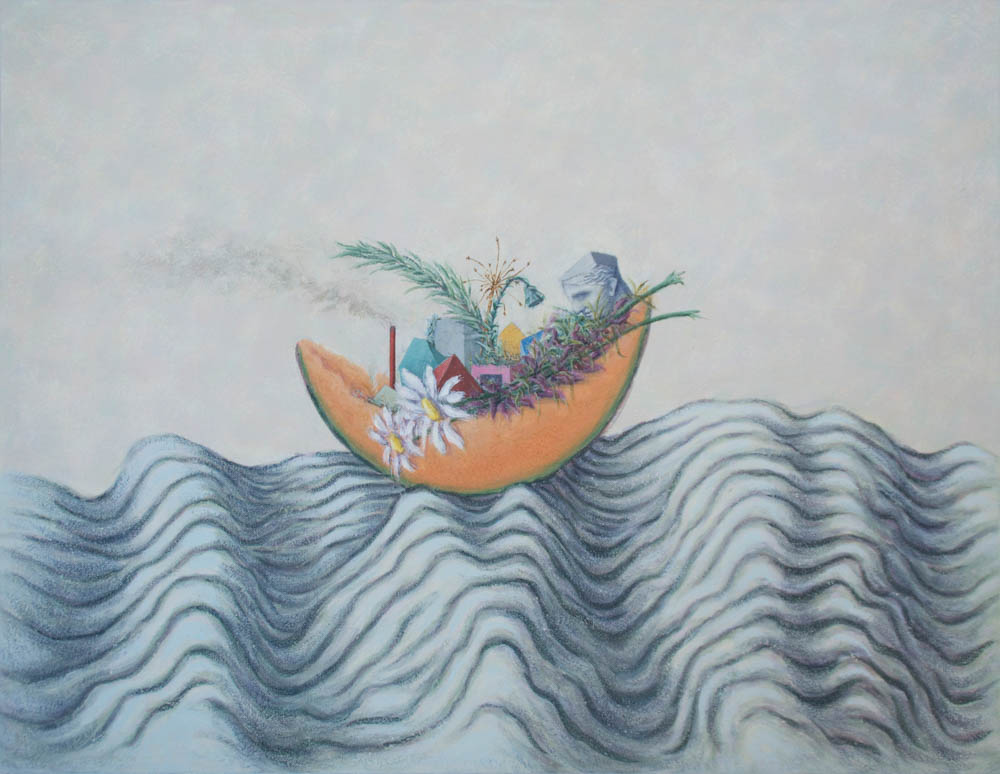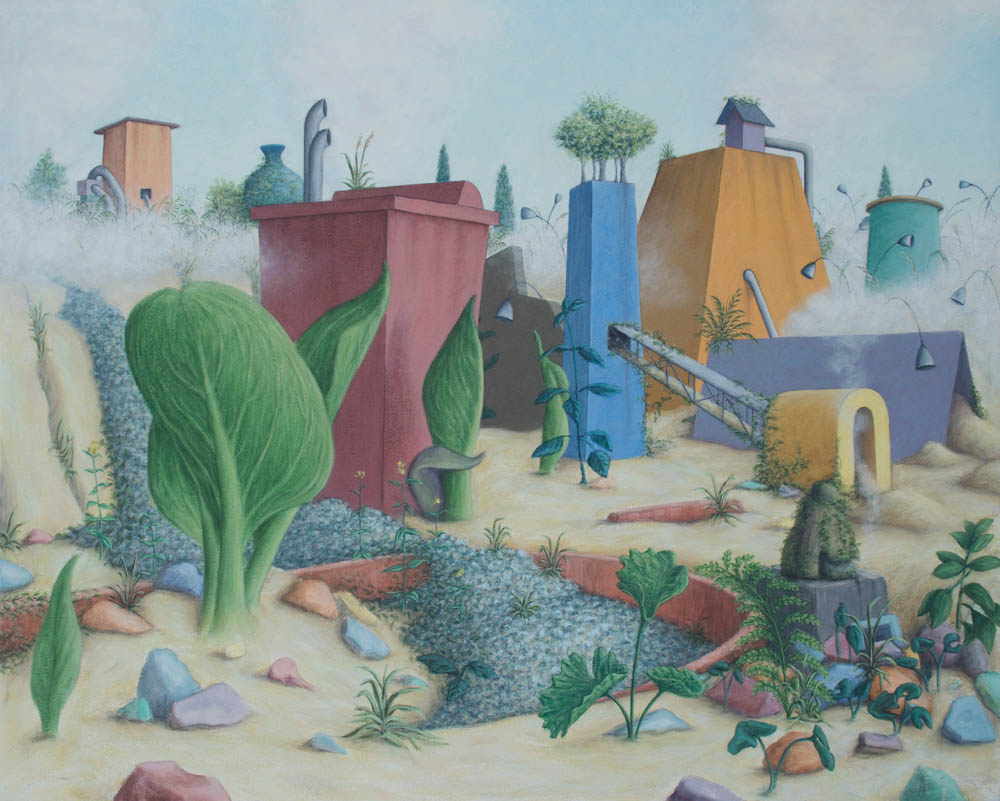Paul Chidester
Interview with Paul Chidester
Questions by Emily Burns
Hi Paul! Congratulations on your recent solo exhibition Psychotopia at the Juniata College Museum of Art. I was able to see the exhibition in person, and it is a stunning show. Thank you so much for the opportunity to find out more about your work. I have had a lot of questions about these paintings for quite some time, and I am excited to be able to get some insight into your process.
Well thank you! I’ll try and make sense of a few things, if I can.
The perspectives in your landscapes appear distinctly real, as if copied from nature, can you talk a little but about how you construct the images? Are you using still life setups of some kind, photographs, or are the scenes entirely from your imagination?
All of the above. I cobble these things together rather slowly, through all of the media you mention (with the addition of drawing). I begin with a huge collection of photographs that I have taken over the years during walks. The photographs as such are quite limited for me, and only serve as material. I mix and pull from many parts of the photographs and begin drawing out compositions. Sometimes there is little or no photographic content, other times quite a bit. The compositions really are pulled together in the drawing process, which pulls equally on other drawings, photographic details, and wherever my imagination takes me from there.
Can you give us some insight into your process from start to finish? How does the composition for a painting begin?
The starting point has always been walking. I like to walk through urban edges, or so called brownfields; all kinds of land areas that resist familiar categorization. You never know what you’re likely to come upon. And there is no substitute for just walking. Last week, my wife and I were on a walk in an area not far from where we’ve both lived for years. Before long we came across a man who was repeatedly spitting, while jogging (in his worn out jeans) up and down a short stretch of roadway near the sewage treatment plant. He was agitated and concerned that our dog might disturb his menagerie of free range giant rabbits. We turned around and saw dozens of these huge floppy eared grey and black rabbits hunched down in little holes all around the roadway and frontage to his house. They were all over the place. I’ve driven along a road that’s in plain view of this spot of ground for years without ever actually knowing what was there. One sees all kinds of things while walking, and I always have a camera with me.
Is sketching an important part of the work? Do you sketch regularly as a habit, or do you set aside time to sketch and work out compositions?
I keep a sketchbook alive always. There are times when a bunch of new images begin to pile up, and i begin to sort out what’s there by drawing out a lot of bits and pieces until something happens. After a lot of revisions, a final sketch is put together and transferred to the painting surface with vine charcoal. Usually, then I set it aside and work on another painting. In order for the painting process to get started, something additional needs to happen that surprises me. Perhaps an unexpected addition, subtraction, or substitution; but something. That’s when it all comes into focus and a painting takes on a life of its own. I buy a lot of erasers at a time. People behind the desk ask me, “Are you planning on making a lot of mistakes?”.
Many of your recent paintings are made with flashe on panel. Did you always work with flashe, and if not, when and why did you make the switch?
I worked with egg-oil tempera for a long time. Back then, I wanted to strike a chord between a formal language that is usually associated with depictions of the sacred, with some rather prosaic subject matter. The panels were small, and kind of precious. Recently, I’ve just wanted to break things up and work a bit bigger. I’m currently depicting architectural spaces and forms on supports made of actual architectural material that I purchase at construction supply houses. The supports and surfaces are integrated, so nothing gets framed. I begin with welded aluminum supports, rigid foam, and and an exterior grade acrylic stucco surface. Flashe is a matte paint that integrates seamlessly with the surface without becoming an active surface distraction in a way that oil paint would.
There are a few distinct patterns that surface throughout your work, such as the black and white stripes, as seen in Meteor, 2011 and Spillway, 2016. When did this pattern (and others) start to appear in your work, and what is the significance?
This body of work began while I was teaching a summer abroad course in Italy. After the course, I stayed on for a few weeks in Siena. I was working away and not really noticing that these sort of Romanesque stripes began creeping into my paintings. Of course, I was walking a lot and one day needed to go out and buy some new socks. When I came home to fix dinner and put them on, I looked at the striped bag and then the striped socks and suddenly understood why the stripes were showing up in the new work. Stripes are everywhere in that part of the world, and Sienese painting has always interested me. I have a kind of fantasy that patterns were used not only for pleasure, but also to describe regions of the cosmos/heavens that the artists couldn’t visualize by any other means. I’ve probably repeated the idea enough though. Time to move on.
The emphasis on the environment itself gives the work a futuristic, dystopian feel. Could you talk a bit about the opposition of the sharp geometry of the man-made structures and the organic quality of the plant life? Also, the lack (mostly) of beings, whether animal or human?
There’s a component of Robert Smithson’s photographs that I have always responded to. And, some of the landscapes in J.G. Ballard’s fiction. Both of them have been influences for a variety of reasons, and the dystopian sense is probably as much a result of these influences as anything else. Things out there also just look out of place to my eyes sometimes. What is that thing doing there? There’s a story about Whistler shooting a dog, while hosting a party. Someone was understandably quite upset by it, and demanded an explanation. He apparently responded, “it didn’t fit with the landscape”. I don’t put figures (or dogs) in my paintings because I want the viewer to enter the space, rather than to be led through it. Also, I alter the scale of just about everything in the paintings, and any figure(s) would highlight the scale shifts, making them less tenable.
I loved the title for your recent exhibition Psychotopia. Can you fill us in on the choice for the title?
Like the paintings, it’s a mashup of sorts. The title combines the notion of mind and place. Also, since walking has played a major role in the generative process in my work for the past 25 years, Debord’s idea of Derive, and Psychogeography has been of interest. Joseph Hart has characterized Psychogeography as: “a whole toy box full of playful, inventive strategies for exploring cities…just about anything that takes pedestrians off their predictable paths and jolts them into a new awareness of the urban landscape."
What is a typical studio day like for you?
I used to work long into the night. Now, I’m a morning worker. As the day wears on, the world comes and gets me. The earlier I can get started, the more I can do.
Are there any books (or essays/poems/films/etc) that have had a profound effect on you?
Russell Edson and Jonathan Williams have been important poetic influences, also Louise Gluck’s series of essays called, “Proofs and Theories”. Herzog’s 1971 film Fata Morgana, De Chirico and Guston’s late paintings, and Ballard’s fiction.
Any advice to recent grads who are interested in getting their work out there and exhibiting?
Start where you can. Make it happen. Participate in a lot of group shows, be judicious about applying to juried shows that charge a fee (don’t do it often, it at all).
What is the best exhibition you have seen recently?
Philip Guston’s Poor Richard Drawings from 1971 at Hauser and Wirth. Political, yes. But he made Nixon and Kissinger into these very human, bumbling, and haplessly tragic characters. We lament their vain and misguided legacy, but their vulnerable humanity is the darker part of the humor.
Anything else you would like to add?
Thanks for coming to the show and taking this time with me!
Thank you for sharing your work with us!
To find out more about Paul and his work, check out his website.







